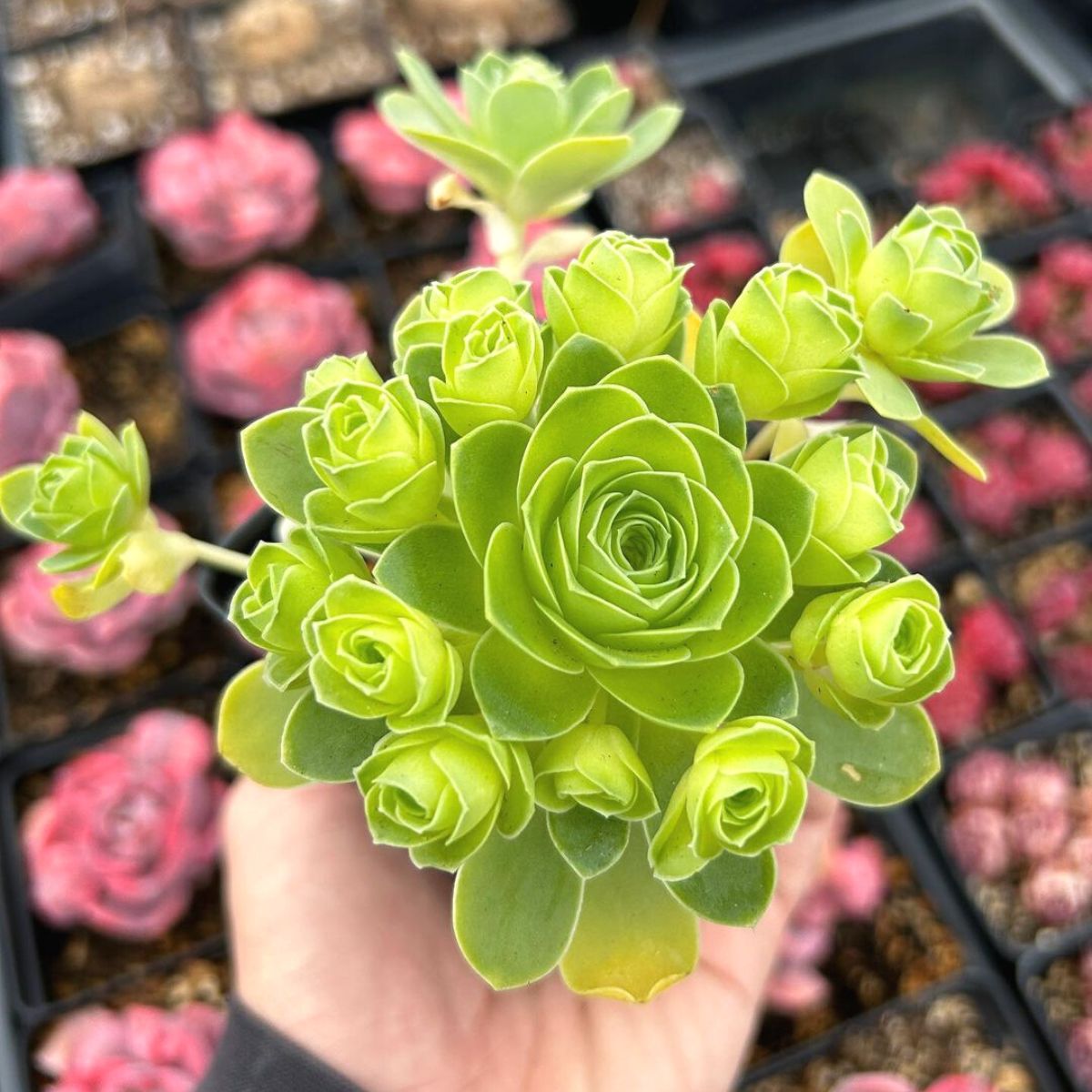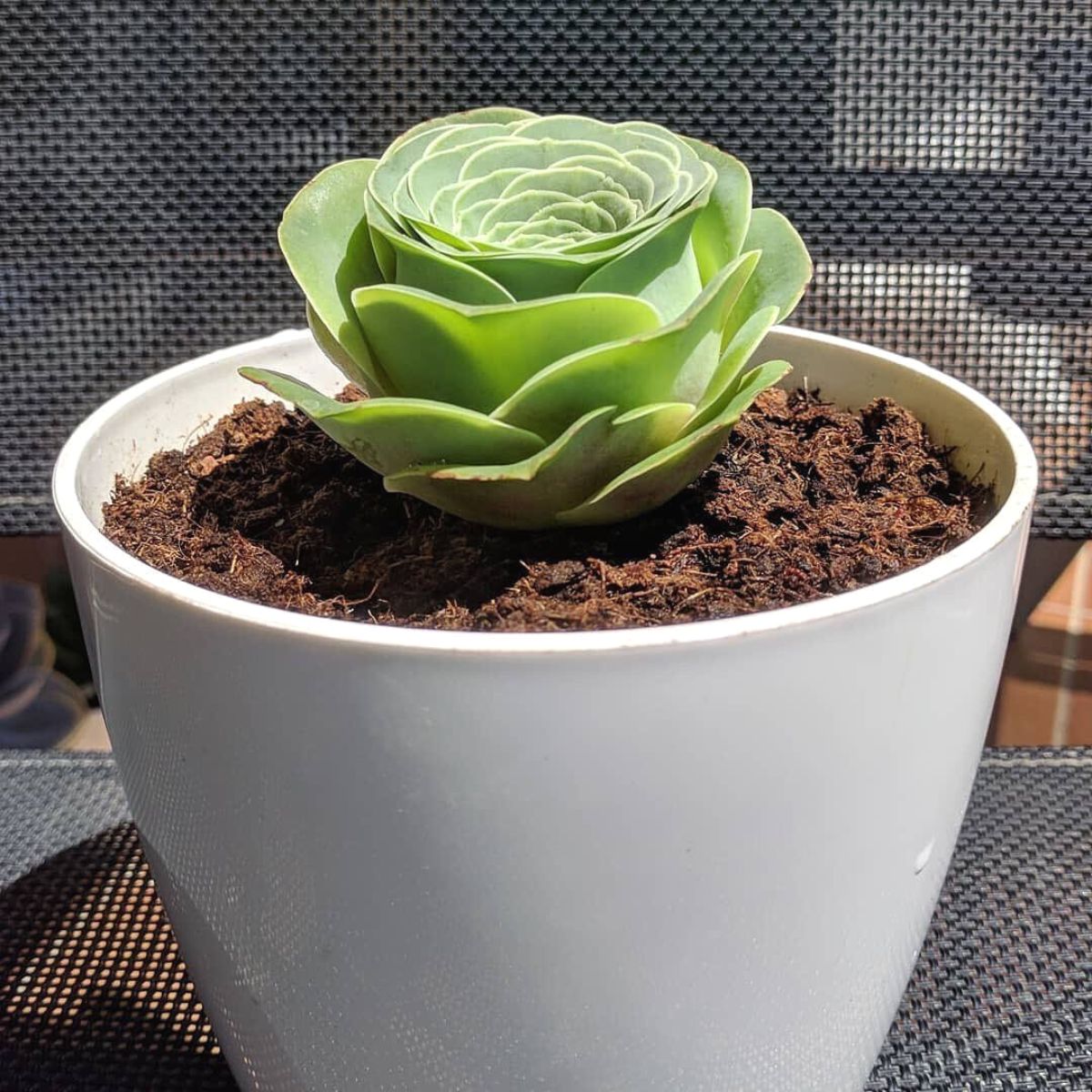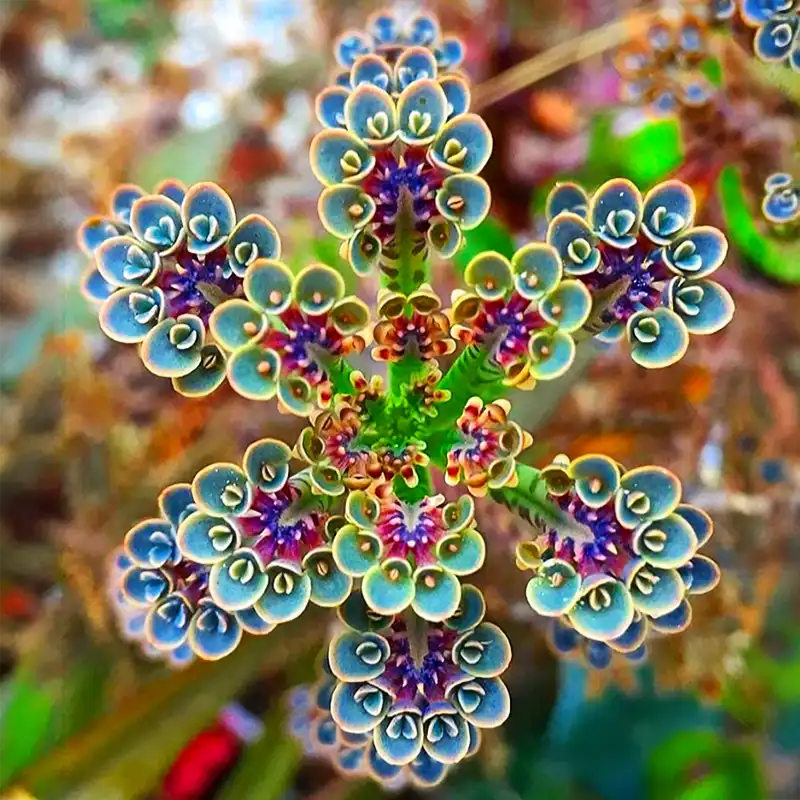From succulents that look like rabbits to cacti resembling tiny dolphins, popular water-storing houseplants come in a variety of interesting shapes and sizes. While many succulents have a prickly, tough appearance, there’s one particular indoor plant that looks as delicate as a flower; in fact, it looks just like a rose. Meet the rose succulent plant, also known as mountain rose, a real-life plant that resembles a rose shape.
What Is a Rose Succulent Plant or Mountain Rose?
With the scientific name Greenovia dodrantalis, the rose succulent is a unique and rare plant that has become increasingly popular among plant lovers in recent years. Its stunning rose-shaped leaves and pastel hues make it a must-have for any succulent lover.

Photo: Earth & Jungle.
Native to the Canary Islands, mountain rose succulents have adapted to their arid environment by developing thick leaves that can store water for extended periods. This makes them particularly low-maintenance, as they only need to be watered sparingly and can withstand droughts. But what makes them so special and distinctive among other succulents and indoor plants?

It's a fascinating rose shape, of course! Have you ever seen such a plant? It's the perfect option to have at home to impress all your incoming guests or even to give as a romantic and more long-lasting gift in the shape of a rose.

Photo: @rayneorshine.sg
The 'leaves' of the known succulent rose are the standout feature of this plant, with each one forming a perfect rosette shape resembling a rose flower. The leaves grow in tight clusters, creating displays of pastel shades, from pale green to lavender pink. The edges of the leaves have a frilled appearance that adds to the plant's overall beauty.

Why Is This the Succulent That Looks Like a Rose?
The leaves of mountain roses are what give them their distinctive rose-like shape. The leaves are arranged in a way that resembles the petals of a rose. The outermost leaves are larger and surround the smaller, inner leaves, creating a tight cluster that looks like a rosebud. As the plant grows, the leaves continue to overlap, creating a spiraling effect that gives the plant a fully bloomed rose appearance. That's why this is the succulent that looks like a rose.

It is believed that the mountain rose has evolved to have this unique shape as a way to protect itself from the harsh environment in which it grows. The thick, fleshy leaves of rose succulents help the plant retain moisture, allowing it to survive in the arid climate of the Canary Islands. The tight rosette shape also protects them from the strong winds that can sweep through the area.

Photo: @phallaspassions
The process of making a succulent rose into a rose shape involves a few simple steps. First, the plant is grown in a tangled shape, with the leaves overlapping tightly. As the plant grows, it is important to trim away any leaves that are growing out of shape, as this can disrupt the spiraling effect of the leaves. Once the plant has reached maturity, it will have the distinctive rose shape that makes it so popular.
Symbolism Behind Rose Succulents
In addition to its distinctive appearance, the rose succulent has become a popular option to have at home due to its symbolism. The rose has long been associated with love and romance, and the mountain rose offers a unique way to incorporate this symbolism into home decor. The plant can be used as a centerpiece in a wedding or special event, or given as a gift to symbolize love and admiration.
The rose succulent is a great addition to any plant collection. Whether used as a centerpiece or as a statement piece in a collection, it is sure to catch the eye and inspire admiration.

Why the Rose Succulent Has Become Such a Popular Plant Option
Greenovia dodrantalis, the scientific name for rose succulent, has become a popular option for home gardeners and plant enthusiasts alike due to its unique and eye-catching appearance, as well as its low maintenance needs. The plant requires bright, indirect sunlight and infrequent watering, making it ideal for those who may not have a lot of time or experience to devote to plant care. Discover how to properly take care of rose succulents.
Another reason rose succulents have become so popular is their versatility. They are often used in succulent arrangements, adding a bit of elegance and softness to the spiky and rugged texture of other succulents.
One of the most distinctive features of the mountain rose is its resemblance to a real rose flower, as previously mentioned. The leaves of the plant are arranged in a tight rosette, with each leaf appearing to curl and overlap like the petals of a rose. The leaves are also thick and fleshy, giving the plant a healthy and sturdy appearance.

Besides this, rose succulent plants can be grown both indoors and outdoors and are easily propagated from cuttings, making them a great option for those who want to share their plant with friends or family.
The succulent rose plant also has a long lifespan, with some plants living up to several years with proper care. This longevity makes it a worthwhile investment for those looking to add a long-term plant to their home or garden; on the other hand, it also makes it a great gift option for those who are devoted fans of having succulents at home.
How to Take Care of a Rose Succulent
Despite their growing popularity, rose succulents remain relatively rare and are often difficult to find in nurseries or garden centers. This has led to their reputation as a collector's plant, with enthusiasts willing to pay high prices for a chance to add one to their collection.
If you're lucky enough to get your hands on one, there are a few things you should know to keep it healthy:
Lighting
Succulent roses require bright, indirect sunlight. They can be placed on a sunny windowsill, but avoid direct sunlight as it can scorch the leaves. If your plant isn't getting enough light, you may notice that the leaves start to stretch out towards the light source, and the plant may become leggy.
Soil
Rose succulents prefer well-draining soil. A cactus or succulent-specific soil mix is ideal, or you can create your own mix by combining regular potting soil with perlite, sand, or gravel. The soil should be allowed to dry out between watering, and make sure to use a pot with drainage holes to prevent overwatering.
Watering
When watering your rose succulent, be sure to water deeply until water comes out of the drainage holes. Then allow the soil to dry out completely before watering again. During the winter months, when the plant is dormant, water sparingly.
Humidity
Rose succulent plants prefer low-humidity environments, so avoid misting or placing them in a bathroom or other humid areas.
Temperature
Rose succulents thrive in temperatures between 15-27°C (60-80°F). They can tolerate cooler temperatures but should be protected from frost and freezing temperatures.
Fertilizer
Fertilize your rose succulent sparingly, using a balanced fertilizer formulated for cacti and succulents. During the growing season (spring and summer), fertilize once a month, and reduce or stop fertilizing during the winter months.
Pest and Disease Control
Rose succulents are generally resistant to pests and diseases. However, mealybugs and spider mites can occasionally become a problem. If you notice any pests, wipe the leaves down with a cotton swab dipped in rubbing alcohol. If the infestation is severe, you may need to use an insecticidal soap or neem oil.

If you care for your succulent rose appropriately, you'll be able to enjoy one of its most appealing aspects—its ability to bloom. When it does, it produces a tall stalk that reaches up to two feet in height, adorned with tiny yellow flowers that provide a lovely contrast to the plant's pastel leaves. The flower is a rare and highly sought-after occurrence, and it is essential to care for the plant properly to encourage it.
How to Propagate Rose Succulent Plants
Propagating succulent rose plants is relatively easy and can be done through a few different methods. Here are some of the most common ways:
- Take a healthy leaf from the plant and let it dry out for a few days until a callus forms over the cut end. Once the callus has formed, plant the leaf cuttings in a well-draining succulent soil mix. Be sure to keep the soil moist but not too wet and place the container in a bright, indirect light. Roots and new leaves should start to form within a few weeks.
- Choose a healthy stem and cut it from the plant with a sharp, sterile knife. Let the cuttings dry out for a few days until a callus forms over the cut end of the succulent rose. Once the callus has formed, plant the stem cutting in a well-draining succulent soil mix. Be sure to keep the soil moist but not too wet and place the container in a bright, indirect light. Roots and new leaves should start to form within a few weeks.
- If your succulent rose has grown to a large size, you can divide it into smaller plants. Gently remove the plant from its container and carefully separate the rosettes from the main stem. Plant the rosettes in well-draining succulent soil mix and water sparingly until they have established roots.
- You can also propagate rose succulents from seed. Sow the seeds in a well-draining succulent soil mix and keep them moist until they germinate. Once the seedlings have grown a few leaves, you can transplant them into their own containers.

While it may be challenging to find in nurseries and garden centers, the mountain rose succulent is well worth the hunt for any collector or plant lover. Now that you already know how to care for and propagate them, go ahead and start your search for your next rose succulent!










